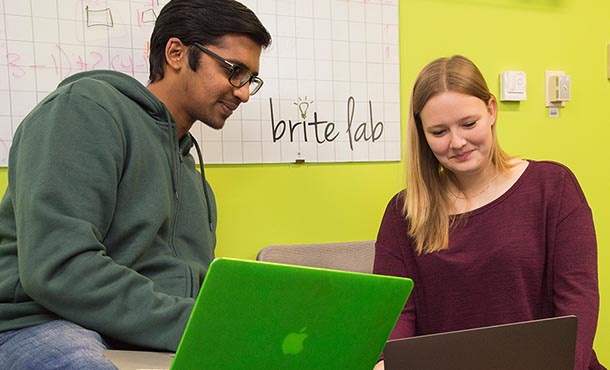
Sharath Ramachandran (left) works with Katie Heininger, industrial engineering alumna, in the Brite Lab. Photo taken Feb. 6, 2018. IMAGE: PENN STATE COLLEGE OF ENGINEERING
Designing and developing the future
Engineering design alumnus applies graduate program education and experiences to improve products and industry
2/22/2021
By Samantha Chavanic
UNIVERSITY PARK, Pa. — After spending four years as a mechanical design engineer at Allegion in Bengaluru, India, Sharath Ramachandran wanted to find a way to enrich his undergraduate mechanical engineering education.
Upon discovering the graduate engineering design (DESIGN) program within the Penn State College of Engineering’s School of Engineering Design, Technology, and Professional Programs (SEDTAPP), Ramachandran knew the program offered exactly was he was looking for — the educational and research opportunities needed to enhance his existing design skills.
Ramachandran focused his studies on developing a better understanding of products and services from a customer-centric lens. He highlighted graduate courses such as EDSGN 581: Design Studio I, EDSGN 582: Design Studio II, EDSGN 548: Interaction Design, DESIGN 562: Design for Additive Manufacturing and ME/IE—546: Designing for Product Families, explaining how experiences in each influenced his design knowledge and capabilities.
“They [EDSGN 581, EDSGN 582 and EDSGN 548] provided me with multiple opportunities in the United States and Europe to directly interact with project sponsors and consumers to help bridge the gap through engineering solutions,” he said. “Rapid prototyping has accelerated product-testing and concept analysis tenfold. They [EDSGN 562 and ME/IE 546:] helped maximize the benefit of these tools in the initial stages of product design over the year.”
Upon graduating with his master of science degree in 2019, Ramachandran joined Assa Abloy as a product development engineer, working on new product development products for electromechanical designs. There, Ramachandran directly applies the concepts he learned and researched in the DESIGN program: He works to understand customer and market requirements, completes competitor product analysis, creates concepts and validates them for new products and designs and develops machine elements. He accomplishes this by using various engineering design tools such as computer-aided design, finite element analysis, design for manufacturing, design for assembly, rapid prototyping and product validation and testing. He also sustains products currently in market by addressing customer issues, if any exist.
“Learning about state-of-the-art design decision-making tools has helped me demonstrate these abilities in a real-world project and estimate goals and deadlines effectively,” Ramachandran said. “The master of science program contributed to providing the skills and knowledge to perform my job efficiently and to advance the field of product design.”
He explained that in addition to providing him with real-world design challenges to solve, the graduate DESIGN program afforded him multiple real-world partnership and engagement opportunities. Ramachandran specifically noted DESIGN’s Design Thinking Week collaboration with the Hasso-Plattner Institut in Potsdam, Germany, and his work as a graduate research assistant under Scarlett Miller, associate professor of engineering design and industrial engineering and director of the DESIGN program.
“The opportunity to interact with designers from around the globe, under the guidance of some of the leading design coaches in the world, was indeed enlightening,” Ramachandran said. “Working as a graduate research assistant under Dr. Miller’s guidance in the Brite Lab and presenting in the ASME [American Society of Mechanical Engineers] IDETC [International Design Engineering Technical Conferences] conference in Quebec, Canada, and having the chance to meet and listen to leading scholars from around the world was eye-opening.”
For Ramachandran, these real-world engagement and research opportunities, the practical aspect of the DESIGN program and SEDTAPP graduate courses delivered an extraordinary experience not found elsewhere.
“The advantage in choosing the graduate DESIGN program is the curriculum allows you to custom-stitch the courses you take, based on your future needs, rather than choosing courses you ‘have to’ take but may not need to meet department requirements,” he said. “If you want to get in the field of design, SEDTAPP provides you with very relevant courses that help you design your future as a product designer in industry.”



